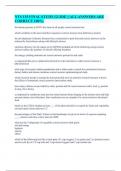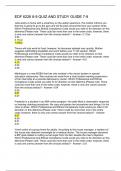-
1. Exam (elaborations) - Basic microbiology questions and answers 2024
-
2. Exam (elaborations) - Brief history of microbiology questions and answers 2024
-
3. Exam (elaborations) - Chapter 1 a brief history of microbiology questions and answers 100% correct
-
4. Exam (elaborations) - Chapter 1 microbiology questions and answers 2024
-
5. Exam (elaborations) - Chapter 1-5 microbiology study guide questions and answers
-
6. Exam (elaborations) - Chapter 3 - microbiology questions and answers 2024
-
7. Exam (elaborations) - Chapter 6-microbiology questions and answers 100% accurate
-
8. Exam (elaborations) - Final westcott micro bio questions and answers 100% accurate
-
9. Exam (elaborations) - History of microbiology- exam -1 questions and answers 100% solved
-
10. Exam (elaborations) - Intro to microbiology questions and answers 100% accurate
-
11. Exam (elaborations) - Introduction to mastering microbiology questions and answers correct
-
12. Exam (elaborations) - Introduction to microbiology - study guide 1 questions and answers 2024
-
13. Exam (elaborations) - Microbiology - exam 1 - chapters 1-4 questions and answers 100% correct
-
14. Exam (elaborations) - Microbiology (chapters 1, 3, 4, 5) questions and answers 100% solved
-
15. Exam (elaborations) - Microbiology 2024 questions and answers 100% correct
-
16. Exam (elaborations) - Microbiology and parasitology questions and answers 100% solved
-
17. Exam (elaborations) - Microbiology basics questions and answers graded a+
-
18. Exam (elaborations) - Microbiology chapter 1 & 2 questions and answers 2024
-
19. Exam (elaborations) - Microbiology chapter 1 2024 questions and answers 2024
-
20. Exam (elaborations) - Microbiology chapter 1 definitions questions and answers 2024
-
21. Exam (elaborations) - Microbiology chapter 1 exam questions and answers 2024
-
22. Exam (elaborations) - Microbiology chapter 1 questions and answers 2024
-
23. Exam (elaborations) - Microbiology chapter 3 questions and answers 100% solved
-
24. Exam (elaborations) - Microbiology chapter 8 questions and answers graded a+
-
25. Exam (elaborations) - Microbiology chapter 14 question and answers 2024
-
26. Exam (elaborations) - Microbiology exam -1 (chapter 1,3,4,5,6) questions and answers graded a+
-
27. Exam (elaborations) - Microbiology exam -1 multiple choice questions and answers fully solved
-
28. Exam (elaborations) - Microbiology exam 1 (chapters 1, 3-5) questions answers 2024
-
29. Exam (elaborations) - Microbiology exam 1 (chapters 1-5) questions and answers fully solved
-
30. Exam (elaborations) - Microbiology exam 1 (pearson) questions and answers 2024
-
31. Exam (elaborations) - Microbiology exam 1 multiple choice questions with solutions 2024
-
32. Exam (elaborations) - Microbiology exam 1 study guide answers 100% solved
-
33. Exam (elaborations) - Microbiology- exam 1 questions with solutions 2024
-
34. Exam (elaborations) - Microbiology exam 2 questions and answers 2024
-
35. Exam (elaborations) - Microbiology exam guide questions and answers 100% accurate
-
36. Exam (elaborations) - Microbiology final exam 1 questions and answers 100% accurate
-
37. Exam (elaborations) - Microbiology final exam questions and answers fully solved
-
38. Exam (elaborations) - Microbiology final exam questions and answers 2024
-
39. Exam (elaborations) - Microbiology for nursing-exam 1 questions and answers 2024
-
40. Exam (elaborations) - Microbiology for surgical tech chapters 1 and 2 questions and answers graded a+
-
41. Exam (elaborations) - Microbiology i - study guide exam 1 questions and answers 100% solved
-
42. Exam (elaborations) - Microbiology lab exam -1 questions and answers 2024
-
43. Exam (elaborations) - Microbiology lab exam 1 questions with solutions 2024
-
44. Exam (elaborations) - Microbiology lab final - osu 4000.01 - prelab & lab quiz questions and answers 2024
-
45. Exam (elaborations) - Microbiology lab study 1-13 questions with solutions 2024
-
46. Exam (elaborations) - Microbiology lecture exam 1. ch. 1, 3, 4, 5 questions and answers
-
47. Exam (elaborations) - Microbiology midterm exam questions and answers 2024
-
48. Exam (elaborations) - Microbiology module 1 and 2 questions and answers graded a+
-
49. Exam (elaborations) - Microbiology questions and answers 2024
-
50. Exam (elaborations) - Microbiology staining questions and answers graded a+
-
51. Exam (elaborations) - Microbiology test 2024 questions and answers
-
52. Exam (elaborations) - Microbiology test questions and answers 100% accurate
-
53. Exam (elaborations) - Microbiology tests questions and answers 2024
-
54. Exam (elaborations) - Microbiology unit 1 exam questions and answers 2024
-
55. Exam (elaborations) - Microbiology. an introduction (tortora) ch. 1 questions and answers graded a+
-
56. Exam (elaborations) - Microbiology. chapter 1-6 test questions and answers 2024
-
57. Exam (elaborations) - Microbiology. pretest questions and answers 2024
-
58. Exam (elaborations) - Microbiology questions and answers 2024
-
59. Exam (elaborations) - Microbiology-scientists and contributions questions and answers 2024
-
60. Exam (elaborations) - Mlt microbiology questions and answers 100% solved
-
Show more







